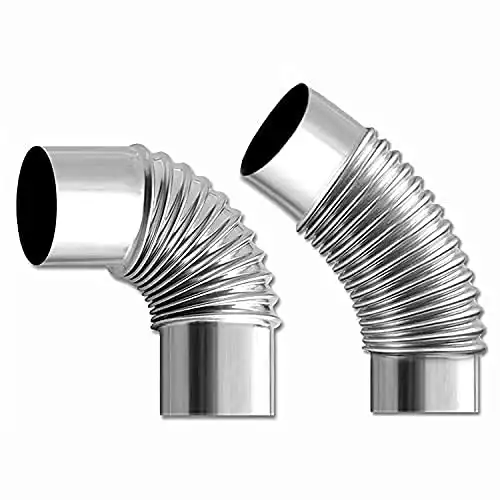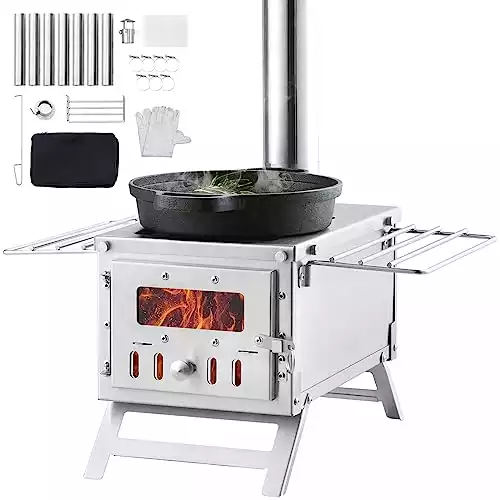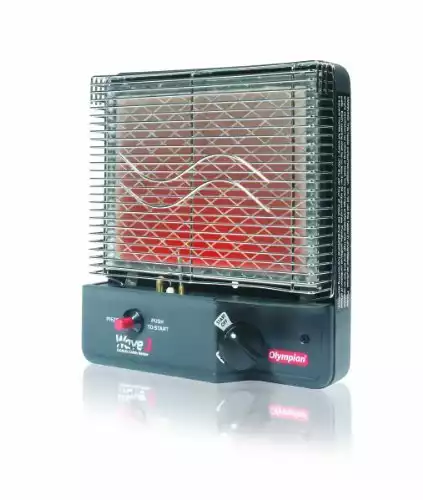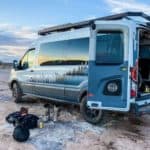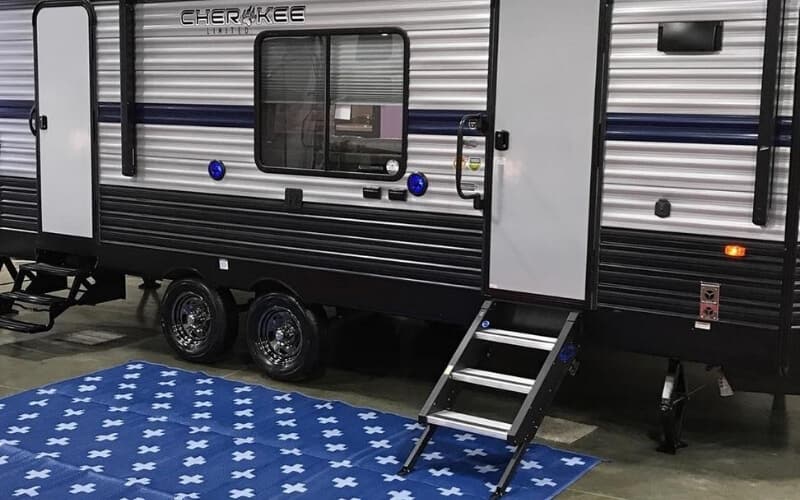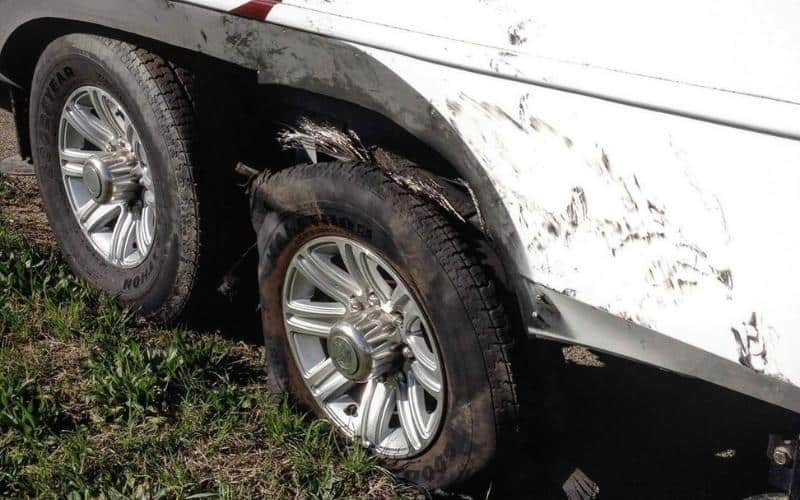Installing a wood stove in RVs isn’t bad if you use the right unit, ventilate, and maintain it correctly. You’ll need an adequate clearance area for the walls, ceiling, and furniture fixtures. However, the wood stove isn’t a good idea for an RV heating source if you’re sensitive to smoke and fumes.
Wood stoves provide heat for RVs with the aid of wood instead of using the propane furnace. You can also cook on top of many models of RV wood stoves.
I’ve used a wood stove in my holiday trailer for three years, camping, moose hunting, and ice climbing west of Nordegg, the hamlet in Canada. Many RV owners have skepticism about installing a wood stove in their vehicles for justifiable reasons.
Here in Alberta, Canada, wood-burning stoves in RVs are commonplace. They allow you to save on heating your RV during winter while enabling you to enjoy the smell of a fresh wood-burning fire. But what are the pros and cons of switching to wood?
Keep reading because I will explain, in great detail, how a wood stove would be a good fit for your RV lifestyle and the necessary measures you can put in place to have a safe camping experience.
Is It Safe To Install A Wood Stove In An RV?
It is safe to install a wood stove in an RV. However, it can take up valuable space and require proper ventilation to prevent the accumulation of fumes.
In other words, wood stoves can enhance your independence, allow you to prepare meals, and create a cozy, charming atmosphere. But they also generate concern for space, weight, ventilation, maintenance, and regulations depending on where you stay.
When some people think of wood stoves, the first thought that comes to mind is a fire hazard. However, wood-burning stoves have become increasingly popular in homes in recent years, and manufacturers have innovated units that can safely serve homes on wheels.
To be safe, the camper wood stove must sit on fireproof flooring called a hearth. The hearth provides a protective barrier between the stove and the floor. Hearths are typically made from tile, stone, marble, or brick.
It’s also a good idea to install a heat shield surrounding the stove to protect the wall and furnishings in your RV from damage due to gradual heat buildup.
Another safety nuance for using wood stoves on RVs is installing a chimney flue to exhaust the gases.
Where Should I Install Wood Stove In My RV?
Position your stove at an angle in a corner since it lets you see the stove from the bed and the doorway. This position also helps you to save space in the RV.
But remember that your stove will be securely bolted to the van’s floor. So be sure the chosen position doesn’t interfere with your vehicle’s wiring loom or fuel tank.
Before installing the wood stove on any corner, inspect the underside of your van to see the risky sections.
Wood Stove Or Electric Fireplace?
Wood stoves and electric fireplaces are two RV heating options worth considering. I’ve read on various RV online communities where camp van owners prefer electric fireplace because it is more convenient to use, does not involve open flames, and come in multiple sizes and designs to suit different RV layouts.
So why would you choose a wood stove instead of an electric fireplace?
As someone who has used wood stoves for years, I’m convinced the real wood fire brings a distinctive cozy crackle.
Also, a wood stove uses no electricity compared to the electric fireplace that needs an onboard generator, so it can keep you toasty even if you’re off-grid.
Pros And Cons Of Installing RV Wood Stoves
As much as a wood stove offers efficient heating for off-grid camping, it’s not for everyone. Before you decide to settle for this heating source, consider the following advantages and disadvantages, some of which I had to learn the hard way.
| Pros | Cons |
| It provides dry heat | Requires effort, such as gathering wood, cutting it into smaller sizes, and emptying ashes. |
| Some models allow you to cook on them. | Since you need an exhaust vent for smoke, you may need to remodel your RV interior. |
| It’s more cost-effective than propane usage. | Not a good idea if you’re sensitive to smoke |
Let’s look at these pros and cons in greater detail.
Cooking On The Wood Stove
The wood stove is the way to go if you want to decrease the propane you use for cooking in your RV. Wood-burning stoves like the VEVOR Camping Wood Stove feature a flat top you can cook on.
I used the Kimberly Wood Stove on my old holiday trailer to make toast, boil water, reheat leftovers, and warm coffee.
Cost-Effective Option
Propane can be expensive, mainly if you use it for heating, running the refrigerator, and cooking. Firewood is a cost-effective alternative to propane. You may be lucky to gather wood for free, but you can also find it cheap from home improvement stores, grocery stores, or gas stations.
Also, some RVers with wood stoves have counted on at least three to six hours of uninterrupted heat from their stoves per load, but some higher-end models can provide up to eight hours of heating.
Requires Effort
Using wood heat requires more work than turning on a switch! In addition to purchasing or gathering the wood, you’ll have to cut it down to the smaller size of the RV stove.
And the smaller the wood is, the faster it will burn. That means reloading every few hours, which can be a chore during a cold night!
You must also empty the ashes and clean out the flue pipe regularly.
Remodeling Your RV Interior For Wood Stove
Since having a wood stove requires an exit vent for the exhaust, you’ll have to cut a hole in the roof or wall of your camper for the flue pipe. It’s understandable if you worry that this is too risky to be worth it.
You might also have to revamp some of your living areas to make a safe, fireproof space for the stove.
If You’re Smoke Sensitive
If you or someone RVing with you have asthma, chronic obstructive pulmonary disease (COPD), or any other respiratory condition, a wood stove might not be the best heating option. And all occupants need to be mindful of carbon monoxide safety. Have working smoke and carbon monoxide detectors in your camper.
What To Consider When Choosing A Wood Stove For Your RV Or Van Conversion
Now that you’ve considered the pros and cons of having a wood-burning stove in your RV, you may be interested in making the switch.
There are several options on the market. So how do you choose the wood-burning stove that is right for you?
Here are three essential areas to consider:
1. What stove size should you get?
When considering the size of the wood stove you should get, you’ll not only have to think about how much space the actual stove will take up, but also you’ll need to know how much clearance will be necessary for safety. Additionally, you’ll need a larger stove if you have a larger camper to heat.
If you plan on cooking on the wood stove, you’ll also need to consider the size of the flat stovetop to be sure it will suit your cooking needs.
2. Is the wood stove EPA-certified?
An EPA-certified appliance meets the Environmental Protection Agency’s clean air standards.
Only new wood-burning stoves can be certified, and this is done during the time of manufacture.
Check the stove itself for clearly marked EPA certification labeling, or go online to see if the organization’s website lists the stove you want to buy in its certification database.
A certified stove is a good choice because it produces less smoke and needs less wood to produce heat. This is good news because your air will be cleaner. In addition, less wood means less work!
3. Is a viewing window a must-have?
Are you interested in spending time in front of your wood stove, watching the bright orange flames flicker, and dancing in your living space? After all, they say the fire is a television for those who don’t have one. Then look for a stove with a viewing window in front!
Some models don’t come with a see-through door, and this can be a no-go for those searching for the cozy ambiance a wood stove can bring to the RV. Otherwise, you can save a bit in getting one without the view.
My Top Recommendations On Small Wood Stove Options For Your RV
I’ve been using the Kimberly Wood Stove for my old holiday trailer. I can recommend this unit in a heartbeat, but you need to consider one that fits your space and is lightweight for easy installation. There’s also the factor of heat output to be sure it suits your RV’s size.
Here are my top five recommendations and why:
- Kimberly Wood Stove
- Cubic Mini Wood Stove—Grizzly And Cub
- The Dwarf 3kw
- Survivor Camp Wood Stoves
- The Salamander Hobbit
Let’s look at these products in greater detail.
1. Kimberly Wood Stove
| Dimensions | Weight | Heat Output | EPA Certified | Price |
| 25.5” high, 10” diameter | 56 lbs | 8,000 to 18,000 BTUs | Yes | $3,750 |
The Kimberly wood stove is a premium choice for RV wood stoves. One of the advantages of this stove is that it can continue burning for up to 8 hours. That means getting an entire night’s sleep without refueling. Remember to invest in carbon monoxide sensors and take all precautions to ensure that there are no flammable things near the stove if you will leave it burning overnight.
The other premium features of the Kimberly are:
- Its sleek stainless steel design.
- The requirement for only 6 inches of clearance space.
- Its ability to heat an area of up to 1,500 square feet of space.
All these premium features come with a premium price tag: almost $3,750. So if the price is not a concern, Kimberly might be the one for you.
2. Cubic Mini Wood Stove—Grizzly And Cub
| Dimensions | Weight | Heat Output | Price | |
| Grizzly Cubic Mini Wood Stove | 15” high, 13” wide | 39 lbs | 8,000 to 18,000 BTUs | $700 |
| Cubic Mini Wood Stove | 12” high, 11” wide | 25 lbs | 6,000 to 14,000 BTUs | $579 |
Grizzly Cubic Mini Wood Stove and the Cub, its newer model, are the same stoves, just in different sizes.
The company suggests the Cub is best for spaces less than 200 square feet. Either option is great for conserving space in your RV.
Both Cubic Mini stoves have a viewing window, removable rail, cooking surface, and gold-plated accents. They also produce very little smoke and are eco-friendly.
3. The Dwarf 3kw
| Dimensions | Weight | Heat Output | Price |
| 17.5” high, 10.25” wide | 75 lbs | 10,236 BTUs | $795 |
If you want a sturdy, traditional wood stove option for your RV, the Dwarf 3kw might be your choice.
This model features a firebox made of brick and cast iron for durability. There’s a large viewing window, so you can easily enjoy the ambiance and monitor the size of the flame.
It also has a flue outlet that can vent from the top or the rear of the stove and out the wall of your RV.
The Dwarf 3kw also has convenient features, such as three air control options to adjust the heat output level. It also has a gate with a lever that operates the floor of the firebox and sifts out the ash. Below that is an ash pan that you can remove easily for cleaning.
The only disadvantage with this unit may be its weight; some may feel that 75 pounds of extra weight is a bit much for towing.
4. Survivor Camp Wood Stoves
| Dimensions | Weight | Heat output | Price | |
| Cub | 11.5” high, 14.5” wide (Add 10.25” to height when legs are installed.) | 38 lbs | 1 Cu. Ft. Firebox | $179 without accessories; $259.99 with accessories |
| Black Bear | 15.5” high, 17” wide (Add 10.25” to height when legs are installed.) | 49 lbs | 1.8 Cu. Ft. Firebox | $199 without accessories; $279.99 with accessories |
| Grizzly | 15.5” high, 17” wide (Add 10.25” to height when legs are installed.) | 63 lbs | 2.7 Cu. Ft. Firebox | $249 without accessories; $319.99 with accessories |
The Survivor Camp Stove might be perfect if you want to use your wood stove for cooking and heating. All three sizes offer a sturdy, large cooking surface that is great for preparing a meal.
Other features include legs that are easy to remove and store inside the firebox when not in use and 12 gauge steel construction that is durable yet lightweight.
The hexagonal firebox provides long burn periods and even heat distribution.
This wood stove model doesn’t have a viewing window, so if you want to see the flames flicker and dance, this wouldn’t be your option.
5. The Salamander Hobbit 4.1kW
| Dimensions | Weight | Heat output | Price |
| 18.3” high, 11.88” wide | 75 lbs | 13,989.8 BTUs | $784 |
Manufactured by an England-based company, Salamander Stoves, the Hobbit wood stove is a solid option for European caravan travelers or van dwellers.
I like this particular unit for its compatibility with a boiler, allowing you to heat water for shower and kitchen use. You can even add a small Ecofan atop the unit to help distribute the heat.
Salamander Stove markets this unit as the best Eco-approved wood stove. You can even burn “eco logs” in The Hobbit instead of wood as a more environmentally friendly alternative. It has a glass window with greatly improved Airwas technology.
How To Install A Wood Stove In A Camper Van Or RV?
One of the perks of using a wood stove is that the entire installation process is DIY-oriented. But if you’re not comfortable handling the whole process, you can outsource to a handyperson or fireplace installer to do it for you.
Here is the step-by-step guide to put you through:
1. Prepare the space you plan to put the stove: Be sure you have made allowance for proper clearance for your specific stove model and installed the heat shielding you plan on using. As mentioned earlier, the wood stove must have a fireproof hearth to sit on. You can even build this as a raised platform to create storage space for wood underneath.
2. Take inventory of all necessary parts to be sure you’re not missing anything: Some wood stove models don’t come with the flue assembly system. You have to purchase these parts separately. So be sure you have everything you need and know each piece. You’ll also want to have the tools you need ready, such as the power tools required for cutting the hole for the flue.
3. Determine which piece goes through the roof (or wall exit): Use this piece to measure the size hole you need to cut to pass the flue system through.
4. Cut the hole that you have measured and then install the chimney pipe. Once you have installed the tube, apply a watertight sealant around the exit point to prevent leaks.
5. Assemble the pipe system and position the stove in its place.
6. Secure the stove on its hearth or platform.
Now it’s time to load the stove with wood, light it, and enjoy!
Wrapping up
So far, we’ve looked into the safety of wood stoves in RVs, the installation process, and the pros and cons. With these in mind, you can decide if a wood stove would be a perfect addition to your RV or camper van.
And as you choose to go with the wood stove as a heating source for your home on wheels, I’ve recommended the top five units worth your consideration.
If you have a wood stove in your RV, you may have extra tips for those thinking of getting one. I’d appreciate it if you shared them in the comment section below.
Stay warm! Stay safe!
FAQs
What are the best camper wood stoves?
The best camper wood stoves combine portability, efficiency, and durability. Some top options include the Grizzly Cubic Mini and Cub, The Salamander Hobbit, and Kimberly. These stoves are perfect for outdoor enthusiasts seeking reliable cooking solutions during camping trips on RVs.
What are the best RV pellet stoves?
I strongly recommend the Dickinson Marine P9000 alongside Camco 57331 Olympian and Dometic 9600019218 as the best RV pellet stoves.
They combine efficiency, compact size, and safety features. These contenders offer reliable heating solutions for RV enthusiasts, making their travels more comfortable and enjoyable.


